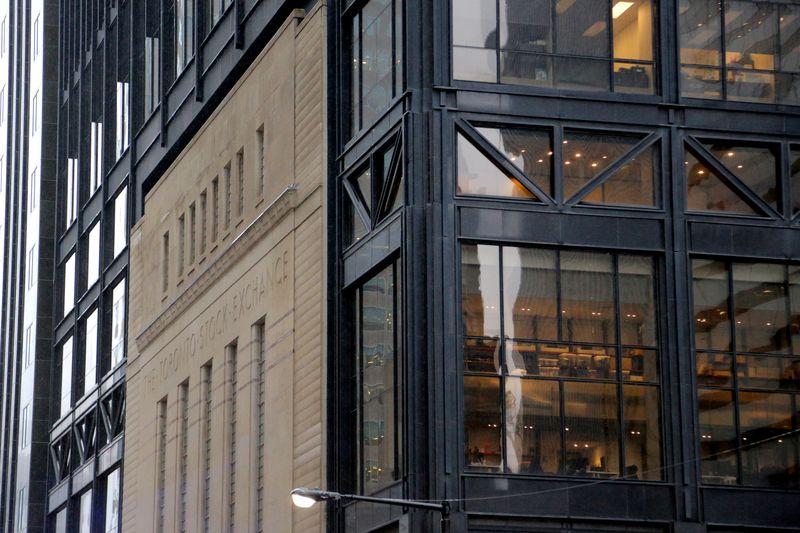SAP sued by o9 Solutions over alleged trade secret theft
Investing.com - Canada’s main stock index sank on Thursday following U.S. President Donald Trump’s announcement of a raft of new tariffs that some believe could upend the decades-old rules-based international trade system.
By the 4:00 ET close, the S&P/TSX 60 index slid by 57.7 points or 3.8%.
The Toronto Stock Exchange’s S&P/TSX composite index finished the day down 971.4 points or 3.8%, having climbed to its highest closing level in over a week in the prior session, which ended before Trump unveiled the levies.
It was the largest fall for the index since June 2020, during the market panic caused by the Covid-19 pandemic.
Trump announced his broadest slate of tariffs to date on Wednesday, saying he would slap a baseline 10% duty on all foreign imports into the U.S. and impose greater levies on several longstanding trading partners in a bid to respond to perceived unfair trade practices.
China, the European Union, India, and Japan are among a number of countries set to face elevated so-called "discounted reciprocal" tariffs that aim to address foreign charges and other non-trade barriers. The White House considers these nations to be "bad actors" on trade.
The broad tariffs take effect on April 5, with the country-specific hikes starting April 9.
Trump had previously rolled out a string of other tariffs that are now in effect, including a 25% import levy on goods from Mexico and Canada not deemed to be in compliance with the U.S.-Mexico-Canada Agreement -- a trade accord signed during Trump’s first term. Energy products and potash received a 10% tariff. Neither country will be subject to any new tariffs beyond these.
A 25% tariff on Canadian steel and aluminum also remains in place.
In response, Canada Prime Minister Mark Carney declared that Canada is implementing 25% tariffs on all vehicles and non-Canadian vehicle content imported from the U.S. that are not compliant with the CUSMA (USMCA) trade pact. Carney alleged that total funds raised from Canada’s tariffs could reach CAD$8 billion, and all funds will go to the autoworkers and companies affected.
U.S. stocks suffer worst day since Covid
U.S. stock indexes plummeted Thursday after Trump revealed his comprehensive trade tariffs, prompting fears of an all-out trade war that could result in a global recession.
Investors responded to Trump’s tariff announcements in fear, with many seeing a global trade war and recession in the near future. U.S. stocks in turn had their worst day since June 2020, when Covid-19 concerns sent markets spiralling.
At the 4:00 ET close, the S&P 500 fell 274.4 points, or 4.8%, its worst day since 2020. The Nasdaq 100 Futures slumped 1,050.4 points, or 6% on the day, also suffering its worst loss since 2020. Additionally, the Dow Jones Industrial Average declined by 1,679.5 points, or 4%.
"Trump’s country-specific reciprocal tariffs turned out to be bigger than expected," said Neil Shearing, Group Chief Economist at Capital Economics.
These tariff policies could see U.S. gross domestic product take a 10% hit in the second quarter of 2025, High Frequency Economics Chief Economist Carl Weinberg said in a note Thursday, potentially pushing the world’s largest economy into a recession after a predicted small contraction in the first quarter.
Weinberg estimated that tariffs would take $741 billion out of U.S. household real incomes or corporate profits, or more if fully accounting for all tariffs on aluminum, steel and non-exempt trade with Canada and Mexico.
Crude prices plummet
Oil prices slid sharply, with the tariffs raising concerns over the prospects for global fuel demand.
At 05:10 ET, Brent futures dropped to $69.85 a barrel, after dropping by as much as 3.2% earlier, its biggest daily percentage decline since March 5.
U.S. West Texas Intermediate crude futures fell 7.1% to $66.62 a barrel after slipping 3.4% earlier.
Gold eases from record highs
Gold prices rushed to a record highs in early Asian trading on Thursday, but later eased back from these levels, with safe-haven demand bolstering the yellow metal.
Trump’s tariffs sparked a severe risk-off move in broader financial markets, underpinning a flight to the perceived safety of assets like gold and the Japanese yen. Gold also benefited from a decline in the dollar.
Spot gold hit a record high of $3,165.64 an ounce, while gold futures expiring in June hit a peak of $3,198.40/oz.
(Scott Kanowsky also contributed to this article)
